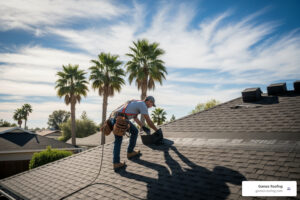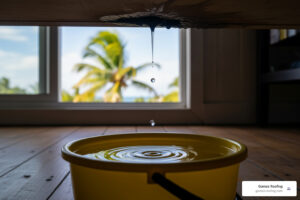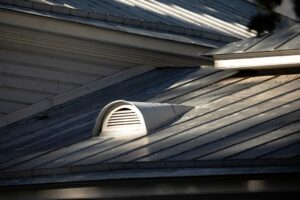Top Materials for Commercial Decking
Choosing the best materials for commercial decking is a decision that directly impacts durability, safety, maintenance budgets, and long-term return on investment. Property managers and business owners face high foot traffic, strict building codes, and aesthetic demands—factors that demand material solutions built to last. In this guide on the best materials for commercial decking, you’ll discover critical considerations—durability, upkeep, cost comparisons, safety features, design versatility, and sustainability—alongside an in-depth look at composite, PVC, wood, metal, and aluminum decking. As a trusted provider of Commercial Decking Solutions – Gomez Roofing, we combine roofing and solar expertise with decking craftsmanship to protect and enhance your property’s value.
What Key Factors Should You Consider When Choosing Commercial Decking Materials?
A successful commercial deck relies on materials that balance longevity, ongoing care, upfront investment, user safety, visual appeal, and environmental responsibility. Evaluating these factors ensures you select decking that aligns with project goals, operational budgets, and code requirements.
How Does Durability Impact Commercial Decking Material Selection?
Durability defines a deck’s ability to withstand heavy foot traffic, UV exposure, moisture cycles, and wear from cleaning or maintenance equipment. Materials with superior rot, insect, and weather resistance minimize repairs and replacement.
- Composite decking endures decades without warping or splintering.
- PVC boards resist moisture damage and decay in poolside or humid environments.
- Tropical hardwoods like ipe deliver natural toughness but require sealing.
Longevity drives cost savings and underpins warranty offerings, making durability the foundation for any commercial decking choice.
Commercial Decking: Professional Guide to Best Materials
Commercial decking materials are engineered for durability, with most solutions made of high-quality wood or composite materials that can withstand heavy traffic and severe weather conditions. High-quality materials partnered with a skilled installation team can ensure the longevity of your deck, providing a tremendous return on your investment.
This source discusses the importance of using durable materials for commercial decking to withstand heavy use and weather conditions.
What Are the Maintenance Requirements for Different Commercial Decking Materials?
Routine care varies dramatically by material and influences lifecycle costs and labor.
- Composite: occasional soap-and-water cleaning and mold prevention treatments.
- PVC: simple rinsing and buffer cleaning to preserve fade resistance.
- Wood: periodic power washing, staining, sealing every 1–3 years to prevent rot.
- Metal/Aluminum: debris removal and annual inspections of fasteners and coatings.
Proper maintenance reduces slip hazards and preserves appearance, reinforcing long-term ROI.
How Do Initial and Long-Term Costs Compare Among Commercial Decking Options?
Decking decisions must weigh upfront installation against projected maintenance budgets over decades.
| Material | Initial Cost (per sq ft) | Annual Maintenance (per sq ft) |
|---|---|---|
| Composite | $8–$12 | $0.30 |
| PVC | $10–$14 | $0.25 |
| Pressure-Treated Wood | $6–$9 | $0.65 |
| Hardwood (Ipe) | $12–$18 | $0.50 |
| Metal/Aluminum | $15–$20 | $0.20 |
Comparing these figures highlights how low-maintenance materials often offset higher initial investments through reduced upkeep.
What Safety Features Are Essential for Commercial Decking Materials?
Commercial decks require engineered slip resistance, fire-rating performance, durable railing systems, and adequate drainage.
- Textured composite and PVC surfaces meet coefficient-of-friction standards.
- Fire-rated wood treatments and non-combustible metal panels support local codes.
- Integrated guardrail channels and ADA-compliant edge details ensure public safety.
Ensuring material compliance with OSHA, ADA, and local fire codes protects occupants and limits liability exposure.
How Do Aesthetics and Design Versatility Influence Commercial Deck Choices?
Visual appeal and customization options affect brand image and customer experience. Materials offering a broad palette of colors, wood-grain finishes, and profile options enable architects and property managers to create inviting outdoor environments that align with corporate identity or hospitality design.
What Is the Environmental Impact and Sustainability of Commercial Decking Materials?
Sustainability considerations include recycled content, embodied energy, and end-of-life recyclability.
- Many composite boards incorporate reclaimed wood fibers and recycled plastics.
- PVC decking avoids volatile organic compounds and is fully recyclable.
- Certified sustainably harvested woods and low-VOC finishes reduce ecological footprints.
Selecting eco-friendly decking can support corporate sustainability goals and green building certifications.
What Are the Benefits and Drawbacks of Composite Decking for Commercial Use?
What Is Composite Decking and How Is It Made?
Composite decking is an engineered product that combines wood fibers and plastic polymers under high pressure and heat. This extrusion process binds materials into durable boards that mimic natural wood while eliminating common timber weaknesses.
What Are the Advantages of Composite Decking in Commercial Settings?
Composite decking provides:
- Exceptional weather resistance and rot prevention.
- Minimal maintenance—no staining or sealing.
- Fade-resistant pigments and mold-inhibiting additives.
- Non-slip surfaces even when wet.
- Manufacturer warranties up to 25 years.
These benefits translate into dependable performance in restaurants, office plazas, and public walkways.
What Are the Potential Disadvantages of Composite Decking?
Composite decking can present:
- Higher upfront costs compared to basic wood options.
- Heat retention under direct sun requiring cooling strategies.
- Limited plank lengths or custom cutting complexity in large projects.
Balancing these drawbacks against lifecycle savings is key for sound budget planning.
Which Commercial Applications Are Best Suited for Composite Decking?
Composite decking excels in:
- Outdoor dining areas at hospitality venues.
- Rooftop patios and amenity decks.
- Public park boardwalks that demand stain resistance.
- Apartment complex common-space decks.
Its low-maintenance and slip-resistant profile make composite a top choice for heavy-use commercial sites.
Why Is PVC Decking a Popular Choice for Commercial Properties?
What Is PVC Decking and What Materials Does It Use?
PVC (polyvinyl chloride) decking is a 100 percent synthetic material formulated with UV stabilizers, color pigments, and impact modifiers. It cures through extrusion into robust, hollow or solid planks.
What Are the Key Benefits of PVC Decking for Commercial Use?
PVC decking offers:
- Total waterproofing that prevents mold and mildew.
- Insect-resistant surfaces safe in coastal or humid climates.
- Fade-resistant color retention with minimal cleaning.
- Lightweight planks that ease installation on elevated structures.
What Are the Limitations of PVC Decking in Commercial Applications?
Potential challenges include:
- Elevated material cost versus composite or wood.
- Occasional squeaking without proper substructure design.
- Fewer textural grain options compared to wood-fiber composites.
Which Commercial Environments Benefit Most from PVC Decking?
PVC decking performs exceptionally in:
- Pool surround areas and marina docks.
- Facility entrances exposed to frequent power washing.
- High-humidity environments like fitness center terraces.
How Does Wood Decking Compare for Commercial Deck Projects?
What Types of Wood Are Commonly Used in Commercial Decking?
Commercial wood decking options include:
- Pressure-treated pine for budget-friendly projects.
- Western red cedar and redwood for natural decay resistance.
- Tropical hardwoods (ipe, tigerwood) for extreme durability.
Selecting the right species balances budget, appearance, and maintenance demands.
What Are the Pros and Cons of Wood Decking in Commercial Settings?
| Wood Type | Advantage | Consideration |
|---|---|---|
| Pressure-Treated Pine | Lower initial cost | Requires annual sealing |
| Cedar/Redwood | Natural rot resistance | Prone to color fading |
| Ipe/Tropical Hardwoods | Exceptional hardness and longevity | Higher material and labor cost |
Wood’s classic aesthetic appeals to design-focused venues but demands ongoing care.
In Which Commercial Situations Is Wood Decking Most Appropriate?
Wood decking suits:
- Low-traffic hospitality terraces.
- Rustic themed retail or café patios.
- Temporary installations where low cost outweighs maintenance.
What Are the Advantages and Considerations of Metal and Aluminum Decking for Commercial Use?
What Types of Metal Decking Are Available for Commercial Projects?
Common metal decking products include:
- Corrugated steel roof deck panels.
- Ribbed aluminum floor planks.
- Composite metal-concrete structural decks.
These profiles serve as both structural support and walking surfaces.
What Benefits Do Metal Decking Materials Offer Commercial Properties?
Metal decking provides:
- Outstanding load-bearing capacity for rooftop amenities.
- Non-combustible surfaces enhancing fire safety.
- Lightweight panels that reduce framing costs.
- Uniform, modern appearance ideal for industrial designs.
What Are the Drawbacks of Metal Decking in Commercial Applications?
Considerations include:
- Higher material and installation complexity.
- Heat conduction requiring under-deck insulation.
- Industrial aesthetic that may not suit all venues.
Which Commercial Decking Projects Are Ideal for Metal and Aluminum Materials?
Metal decking excels in:
- Rooftop lounge areas with strict fire codes.
- Industrial facility walkways.
- Elevated platforms where weight reduction is critical.
How Do Commercial Decking Materials Compare in Durability, Maintenance, Cost, and Safety?
What Are the Key Attributes to Compare Across Commercial Decking Materials?
Key performance attributes include:
- Durability under UV, moisture, and heavy use.
- Maintenance frequency and complexity.
- Initial investment versus lifecycle cost.
- Slip resistance and fire-rating compliance.
Evaluating all four together reveals the most cost-effective solution.
How Does Each Material Rank in These Key Attributes?
| Material | Durability (1–5) | Maintenance (1–5) | Cost (1–5) | Safety (1–5) |
|---|---|---|---|---|
| Composite | 5 | 5 | 3 | 5 |
| PVC | 5 | 5 | 2 | 5 |
| Hardwood (Ipe) | 5 | 3 | 2 | 4 |
| Treated Wood | 3 | 2 | 4 | 3 |
| Metal/Alum | 5 | 4 | 1 | 4 |
Composite and PVC deliver the highest combined scores for durability and safety, while metal offers the strongest fire performance.
Which Material Offers the Best Return on Investment for Commercial Decking?
Composite decking typically offers the strongest ROI by minimizing maintenance costs and maximizing warranty coverage. PVC decking follows closely for moisture-intensive projects, while metal and hardwoods serve specialized applications where their unique benefits justify higher upfront costs.
What Commercial Decking Regulations and Building Codes Must You Follow?
Why Is Compliance with Local Building Codes Critical for Commercial Decking?
Compliance ensures structural integrity, public safety, and legal liability protection. Local codes dictate load capacities, railing heights, fire ratings, and exit pathways that your deck must meet before occupancy.
Commercial Deck Requirements and Recommendations
Commercial decks are subject to additional building requirements and regulations to help ensure people’s safety, unlike residential decks. The International Building Code (IBC) regulates commercial decks, adding measures to accommodate the extra capacity and foot traffic expected from commercial decks.
This source highlights the importance of adhering to building codes for commercial decks to ensure safety and structural integrity.
What Are the Common Safety and Accessibility Standards for Commercial Decks?
Commercial decks often require:
- ADA-compliant ramp slopes and tactile warning strips.
- Minimum guardrail heights of 42 inches and intermediate rail spacing.
- Fire-rated material approvals and sprinkler access in rooftop decks.
Meeting these standards safeguards patrons and limits code violation risks.
Deck Building Codes: Unveiling Essential Guidelines and Regulations
Building codes for decks dictate construction standards to ensure structures are safe and resilient. These codes cover all aspects of deck building, from the ground up, and understanding them is crucial for a successful build.
This source emphasizes the importance of understanding and following deck building codes for safety and structural integrity.
How Does Gomez Roofing Ensure Your Commercial Deck Meets All Regulations?
As part of Gomez Roofing – Dependable Roofing and Solar Solutions, our team integrates code-driven design checks, licensed inspections, and meticulous documentation. Every decking project follows a compliance roadmap aligned with municipal and ADA guidelines to deliver safe, legal installations.
Why Should You Choose Gomez Roofing for Your Commercial Decking Material and Installation Needs?
What Expertise Does Gomez Roofing Bring to Commercial Decking Projects?
Gomez Roofing combines decades of local roofing and solar installation experience with specialized decking craftsmanship. Our certified installers understand roof load limits, waterproofing best practices, and structural safety—ensuring seamless integration of decks into existing buildings.
How Does Gomez Roofing Support Material Selection and Long-Term Maintenance?
We guide clients through material comparisons—durability metrics, design options, and lifecycle cost analyses—to select the ideal decking solution. Post-installation, our service agreements cover scheduled cleaning, inspections, and warranty management for ongoing peace of mind.
What Are the Benefits of Partnering with Gomez Roofing for Commercial Decking?
- Proven track record of on-time, on-budget delivery.
- Customized design consultations tailored to brand identity.
- Comprehensive warranties and dedicated maintenance programs.
- Local code expertise and licensed project oversight.
Partnering with Gomez Roofing means investing in a dependable team committed to maximizing your deck’s performance and appeal.
What Are the Most Frequently Asked Questions About Commercial Decking Materials?
Many property managers ask about durability, cost differences, and maintenance obligations when selecting commercial decking. For detailed answers and project-specific guidance, visit our Commercial Decking Solutions – Gomez Roofing page or contact our experts.
Commercial decking choices shape every aspect of functionality, safety, and aesthetics for busy establishments. Working with an experienced provider like Gomez Roofing guarantees expert material selection, code-compliant installations, and long-term support tailored to your property’s needs. Contact us today to schedule a consultation and discover the ideal commercial decking solution for your business.




